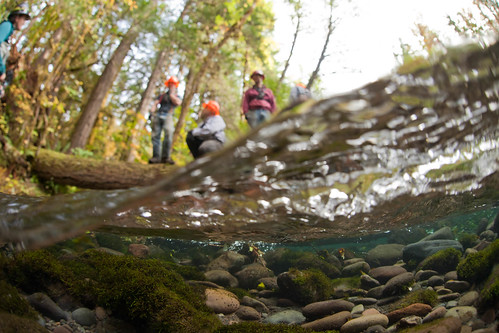
Arising in the Willamette National Forest, the Mckenzie River is one of the largest Willamette River tributaries and is a stronghold for Wild Spring Chinook Salmon that rely on its pure water and clean gravels to spawn. Photo: David Herasimtschuk, Freshwaters Illustrated
Oregon’s McKenzie River has a lot to boast about. One of the cleanest and coldest rivers in the country, it’s the most important tributary for wild spring Chinook salmon and Bull trout production in the entire Willamette River Basin. It’s part of more than 100 miles of streams that the Willamette National Forest and many partners have restored over the last 10 years.
“What happens around these headwaters has important implications downstream,” said Kate Meyer, a fisheries biologist on the Willamette National Forest. “Land managed by the Forest Service makes up 66 percent of the McKenzie River Sub-basin and 24 percent of the Willamette River Basin, and it’s the source of 74 percent and 31 percent of the water feeding each river respectively.”
Efforts to protect and restore streams for the fish and wildlife that depend on them are part of one of the most remarkable restoration efforts in the country. The Willamette National Forest and various partners throughout the Willamette River Basin are part of a movement which spans vast areas from small headwater streams to major rivers and demonstrates how the Willamette River—like all rivers—connect us all.
Upriver, a new film to debut March 18 at the D.C. Environmental Film Festival, captures the pulse of that movement and the inspired work of a network of conservation and restoration stewards. Stunning photography is combined with shared stories of a sustaining purpose, common to all.
Within Oregon’s heavily populated Willamette River system, the forest plays a central role along with local, state and national organizations and volunteers to revive the health of this large river and the life it supports.

In response to widespread loss of logjams and gravel from Mckenzie river habitats over the last century, a tree-tipping crew works in side channels of the river to pull streamside trees into the channel to enhance this precious spawning and rearing habitat for Chinook Salmon and other aquatic species. Photo: David Herasimtschuk, Freshwaters Illustrated
Watch as fallen trees are harvested and “tipped” into the river. Helicopters fly in additional wood to restore streams and fish habitat. Follow the spawning and snorkel surveys that capture the life-creating moments of Chinook and Bull trout spawning rituals as if you were swimming alongside the fish.
“You may not know this, but there is something happening on a river in Oregon. A river that gathers its waters and flows straight north to most of the people in this state and through their most essential needs.” – Upriver
The film examines a number of topics central to the forest’s watershed stewardship program including the protection of clean water resources and quality habitat through the collaboration of partners and volunteers to ensure that future generations are able to enjoy their National Forest and the benefits it provides.
The film also profiles the Middle McKenzie Side Channel floodplain enhancement project, another USDA Forest Service restoration project and highlights the ways volunteers are helping on projects.
“It’s a synchrony of human will and deliberate action and it might be one of the most powerful river conservation movements we’ve ever seen.” – Upriver
Watch the film trailer and begin exploring one of the nation’s most active river conservation movements. Visit our Naturewatch site to view the full 60 minute film (to be posted soon).
If you are in Washington, please join us Friday, March 18 for the free showing of the film and speakers panel on watersheds to follow at the U.S. Department of Agriculture, Jefferson Auditorium at 1400 Independence Ave., S.W., Washington D.C. South Building, Wing 4. For confirmation, emailkawinter@fs.fed.us with the subject line “RSVP” and your full name. Please arrive at least 30 minutes early to allow for security screening. Photo ID is required.
Panelists will include USDA’s Forest Service Chief Tom Tidwell and Natural Resources Conservation Service Chief Jason Weller, American Rivers President Bob Irvin, National Fish and Wildlife Foundation Scientist David Lawrence and the Willamette River Initiative’s Allison Hensey.

Cascade springs well up from vast underground aquifers throughout the Willamette and Mount Hood National Forests, and delivers extremely pure, cold water to the Willamette River. Forest Service policies maintain the quality of this water through protection of streamside forests. Photo: David Herasimtschuk, Freshwaters Illustrated
No comments:
Post a Comment
Note: Only a member of this blog may post a comment.